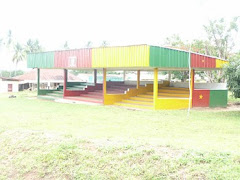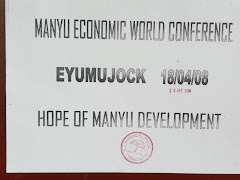
A question that often comes to mind is - how do we start attacking the energy crisis that has plagued our people for many years? The absence of reliable energy in Mamfe means the entire division, and more so the rural areas will continue to witness poverty, falling standards in education, healthcare and water crisis linked to lack of access to electricity. The idea of renewable energy as a viable solution or an alternative in lieu of diesel generators producing noise and polluting the environment sounds plausible. However, introducing renewable energy has not been practical in years past due to the high cost of Solar panels and understanding technology applications. Despite falling prices and eventual diffusion of alternative energy solutions in rural communities across Africa and the World, questions still remain in the case of Manyu. What is our strategy to relieve the many poor villages and rural inhabitants of Manyu out of darkness and isolation? How long will it take for us to realize we have a role to play in initiating the change and development we seek – either as advocates or implementers? Will our children in some far remote villages ever work on a computer before they graduate from secondary school? How many more kids will die in villages because they were bitten by a snake and the nearby local clinic had no anti snake venom due to lack of a refrigerator. These are some of the questions we
must analyze, and seek potential and realistic solutions.
A greater portion of the rural inhabitants of our division have no access to modern forms of energy such as electricity. The energy needs of our people are mostly met by traditional fuel that has been in use for
 centuries. With over 90% of our folks living in villages, traditional fuels such as wood and crop residue are the only energy source they have ever known. Whereas this type of energy has served them for cooking and kerosene lightning, the accumulated adverse effect over many years can become a health hazard. Science has taught us that burning fuels increases indoor air pollution, which affects the health of vulnerable young people and the elderly.
centuries. With over 90% of our folks living in villages, traditional fuels such as wood and crop residue are the only energy source they have ever known. Whereas this type of energy has served them for cooking and kerosene lightning, the accumulated adverse effect over many years can become a health hazard. Science has taught us that burning fuels increases indoor air pollution, which affects the health of vulnerable young people and the elderly.Despite some advances, electrifying rural areas in Manyu division will no doubt remain a unique challenge even for the government of Cameroon for many years to come. From an economic standpoint, our remote and scattered rural homes are costly and often impractical to connect to the national grid. The current policy of the Utility Company is to satisfy urban customers and major industries who pay more. Secondly, the government has not formulated a national policy or effectively promoted renewable energy as part of its overall rural electrification strategy to enhance economic and social life.
A cursory look at the energy statistics in Cameroon paints a gray picture, and reminds us of the enormous task ahead. Overall electricity access is 46%, with 11% of rural households having electricity but subject to constant cuts, and interruptions lasting days. Approximately 80% of the rural populations use wood fuel or charcoal to meet energy needs. Out of 15,000 villages, 14% have electricity that is 1 out of every 1500. It is estimated that the lack of reliable energy service is costing the economy tremendously in terms of GDP growth.
In 2001, Sonel was privatized through a 20 year concession and granted monopoly over transmission and distribution of electricity throughout the country and the right to own 1000MW of installed generated capacity. Cameroon is dependent on hydroelectricity with an installed base of 77% hydro and 22% thermal (diesel and heavy fuel), but the major rivers are drying up due to global warming. In essence, investment in hydro dominated power system has not kept up with demand growth - risking shortages’ and load shedding particularly in rural and peri-urban areas.

There are 3 existing reservoirs in the nation but they do not have sufficient storage to maintain reliable power supply during the dry season. Currently there is a project to build the Lom Pangar dam. However the country will still need additional hydro power from 2012-13 and up to accommodate planned industrial projects such as expansion of Alucam, several iron, cobalt, bauxite and other mining projects under negotiation. It must be noted that Alucam accounts for 35% of total power consumption in the country and benefits from a guaranteed supply of 20% of national output.
So what is the panacea for the energy situation in Manyu? Every day we hear horror but true stories of Mamfe with no light and no water for two weeks. The power grid reaching Mamfe passes through the dense equatorial forest from Bamenda and is subject sometimes to trees, birds and snakes falling on high tension lines and causing short circuits. However, that is an iceberg to the problem. As illustrated above, there isn’t enough energy supply to reach Mamfe and nothing will change for the foreseeable future. Energy sector development in Cameroon has been subject to economic interest, political influence and weakness in sector planning.
We as a people have an obligation and a moral/economic duty to address and find a solution in the short term to our energy crises. We must start thinking out of the box and take proactive positions which will enhance the living conditions of our people. No electricity in Manyu means kids cannot do home work at night. Our parents will drink water from polluted streams and rivers. Standard of living will continue to deteriorate, more social exclusion and increased inequity between urban and rural areas, increased unemployment and urban migration in search of jobs.
Renewable energy and standalone energy such as Solar and wind power are the only solution to help fill the electricity void in Manyu. The sun is free and inexhaustible in our area with a solar irradiance of about 5 hours a day. Solar photovoltaic panels – convert the sun’s radiation directly to electricity with no pollution, little maintenance and long term reliability lasting 20-25 years for a one time investment. The panels generate enough power to run stoves, pump water, light clinics, schools, community centers and entire villages and towns. It is time to move Manyu out of the less traditional energy sources such as wood, biomass (crop waste) dominant for cooking. This comes at a huge cost to our long term health and environment with falling of trees. Manyu must therefore embrace Solar technology as other rural communities around the world are doing – India, China, Pakistan, Bangladesh, Kenya, Tanzania, South Africa, Ethiopia etc, to witness economic expansion, unprecedented social uplifting and poverty alleviation. The time is now and organizations such as MECA USA must take the lead in education, sensitization and development of pilot initiatives. We cannot wait another 20 years for the power grid to come to our communities. Our educational levels and standard of living will continue to fall and we as a people will hence play second fiddle to the future development of Cameroon. Can Manyu afford to wait idle as development passes us by in this age of internet technology and globalization?
Note: Summary of a power point presentation delivered during the MECA USA 20th annual convention in Atlanta, Georgia - July 3, 2010. The writer has a strong background in Telecommunications and serves as Acting Director of Communication Services for the City of Baltimore - Government.



























